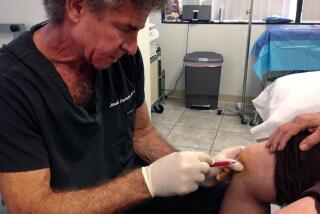Bush OKs Limited Stem Cell Funding
- Share via
CRAWFORD, Texas — President Bush, seeking a compromise in the most politically charged issue of his administration, announced Thursday that he would allow the federal government to fund medical research that uses stem cells taken from a limited number of human embryos.
But in a significant constraint, the president said that the government would pay only for experiments using stem cells that already have been drawn from embryos and that it would not fund research that caused any additional embryos to be destroyed.
“This allows us to explore the promise and potential of stem cell research without crossing a fundamental moral line by providing taxpayer funding that would sanction or encourage further destruction of human embryos,” the president said in his first prime-time address to the nation since taking office.
In making the decision, Bush risked either angering patient advocacy groups that say the embryo cells hold the key to curing a range of diseases or alienating his politically potent allies in the anti-abortion movement who think the research is immoral because it requires the destruction of embryos.
But his decision cut a narrow middle ground that seemed neither to please nor anger either side in its entirety.
Abortion opponents, who had promised to punish Bush if he moved too far in supporting the research, were split. “We’re delighted,” said Laura Echevarria, spokeswoman for the National Right to Life Committee. “We’re happy with the decision because it prevents embryos in the future from being killed.”
But the U.S. Conference of Catholic Bishops declared the decision “morally unacceptable” because the government should not benefit even from the past destruction of embryos, which it considers to be tantamount to murder.
Several prominent scientists immediately criticized the decision, saying that Bush had adopted restrictions that would prevent the government from jump-starting the single most promising avenue of medical research. Embryo stem cells can grow into nearly any type of tissue in the body, and scientists hope to learn how to mold them into heart cells for cardiac patients, pancreas cells for diabetics and replacement brain cells for people with Parkinson’s or Alzheimer’s disease.
In particular, researchers questioned Bush’s claim that private companies had already created 60 sets of stem cells, or cell lines, from human embryos and that research could advance using only those cells.
Last month, the National Institutes of Health conducted a detailed survey and found 30 cell lines, some of which did not come from embryos and which therefore might not be as useful. Douglas Melton, a leading researcher and chairman of Harvard University’s department of molecular and cellular biology, said that only 10 of those lines had been described in scientific publications and that little was known about the others.
“And some of those 10 cell lines don’t grow well at all and are largely useless,” Melton said. “There are only one or two that I know of that are helpful.” Moreover, he said, private companies hold the rights to some of the existing cell lines, and they are not willing to share them on terms that academic researchers can accept.
“Those existing cell lines were generated with old technology,” said Evan Snyder, another leading researcher, who works at Children’s Hospital in Boston. “What if next week we find a new gene or growth factor that creates stem cells that are safer and more effective? The president has banned them” from being used in federally funded experiments.
The decision also has the potential to spark a battle with Congress. A majority of lawmakers in both the House and Senate had asked Bush to fund the research. Several senators have been pushing for a far broader set of research rules than Bush adopted, and Senate Majority Leader Tom Daschle (D-S.D.) said Thursday night that the Senate would likely review Bush’s stance.
“I think there are going to be Senate hearings on this proposal, and they’re going to bring in the top scientists,” said Lawrence Soler of the Juvenile Diabetes Research Foundation, which helped lead a campaign by patient advocacy groups in favor of the research. “This gives the administration a few weeks to try to prove to the top scientists in the field that their skepticism is unfounded.”
In his remarks, broadcast from his Texas ranch, Bush said he had carefully weighed the promise of the research with the fear that destroying embryos demeans human life. He said the nation is grappling with a range of laboratory reports regarding the earliest forms of human life, including news that some scientists already are moving to produce cloned human embryos, a move that Bush said he strongly opposes.
The president said that, “like all Americans, I have great hope for cures. I also believe human life is a sacred gift from our creator. I worry about a culture that devalues life and believe, as your president, I have an important obligation to foster and encourage respect for life in America and throughout the world.”
In balancing the “great promise and great peril” of the research, Bush said he would limit federal funding for research using only those sets of stem cells that already have been drawn from human embryos.
Nearly all of those embryos were created by patients at fertility clinics. These patients commonly create more embryos than they need to produce a child and discard the extras. Instead, some patients had donated their embryos to privately funded researchers, who had extracted the stem cells.
Bush said the “life-and-death decision” had already been made to destroy 60 of those embryos to create stem cell lines. “Leading scientists tell me research on these 60 lines has great promise that can lead to breakthrough therapies and cures,” he said.
But he said it was not proper to use taxpayer money to destroy new human embryos.
The president also said he would establish a council of ethicists, scientists, theologians and others to monitor scientific and ethical developments in stem cell research.
No federal law bars private companies from extracting stem cells from human embryos or studying them. But the federal government is by far the largest supporter of U.S. medical research, and a broad commitment to financial support would draw many more researchers to the field, several scientists said.
That Bush devoted a nationally televised speech to stem cell research showed how prominent the issue has become in only a few months. It was scarcely debated in the presidential campaign last fall, though Bush, through spokespersons and in written statements, said he opposed federal funding for the experiments.
But research advocates harnessed the power of celebrities--including actors Christopher Reeve who is paralyzed by a spinal cord injury, and Michael J. Fox, who has Parkinson’s--as well as lobbying by ordinary patients hoping for cures to bring attention to the issue. Their appeals helped persuade a large number of abortion opponents in Congress to support the research.
At least 38 House Republicans asked Bush to support the research, and Sen. Arlen Specter (R-Pa.) claimed that more than 70 senators wanted the federal funding. They included such solid abortion opponents as Sens. Orrin G. Hatch (R-Utah), Strom Thurmond (R-S.C.) and Bill Frist (R-Tenn.), the only physician in the Senate and an advisor to Bush on health matters.
Still, some White House aides feared that Bush would alienate key supporters if he backed the research. In particular, aides worried that Bush might forfeit gains that Republican presidential candidates have made among Catholic voters in swing states, such as Illinois and Pennsylvania.
Before making his decision, Bush heard or solicited the opinions of bioethicists, scientists at the National Institutes of Health and Pope John Paul II, who denounced the research in a personal meeting with the president.
When embryonic stem cells were first isolated in late 1998, by researcher James Thomson of the University of Wisconsin in Madison, the journal Science dubbed it the “breakthrough of the year,” and scientists began talking of a revolution in medicine.
But the National Institutes of Health was unsure whether it could use taxpayer money to support the research. A 1996 federal law bars federal funding for “research in which a human embryo or embryos are destroyed.”
With the support of President Clinton’s administration, the NIH obtained a legal opinion that said the federal ban barred the agency from paying scientists to extract stem cells from human embryos. But if private money paid to obtain the cells, the NIH was free to use taxpayer money to fund experiments using those cells, the opinion said.
Last August, the NIH announced that it would accept grant applications for stem cell projects that met certain conditions. Researchers could use only stem cells that came from frozen embryos produced by couples at fertility clinics and which the couples no longer needed to produce children. Donors of the embryos would be required to sign detailed informed consent forms. And no federal money would pay for the creation of embryos solely for research or human cloning.
Bush put the NIH plan on hold shortly after taking office and began a review of the law and ethics of the research.
*
Chen reported from Crawford and Zitner from Washington.
(BEGIN TEXT OF INFOBOX / INFOGRAPHIC)
Stem Cells From Embryos
As they divide, stem cells produce more stem cells, as well as cells that specialize into the more than 200 other cell types in the body. Here’s a look at stem cells extracted from embryos:
After a fertilized egg has gone through a few divisions, it forms a cluster of about 30 to 150 cells known as a blastocyst, a process that takes about five days. It is only at this point that embryonic stem cells can be extracted and used for research.
Scientists are hoping to discover how embryonic stem cells become specialized so they can develop techniques for repairing diseased tissues and organs.
*
Sources: Dorling Kindersley Ultimate Visual Dictionary; The Human Body *
MORE INSIDE
Critics speak up: President Bush’s decision draws sharp criticism. A19
Key focus: The ethical issues are viewed as major concerns. A19
New frontiers: Science and society at “crossroads,” advisor says. A20






